
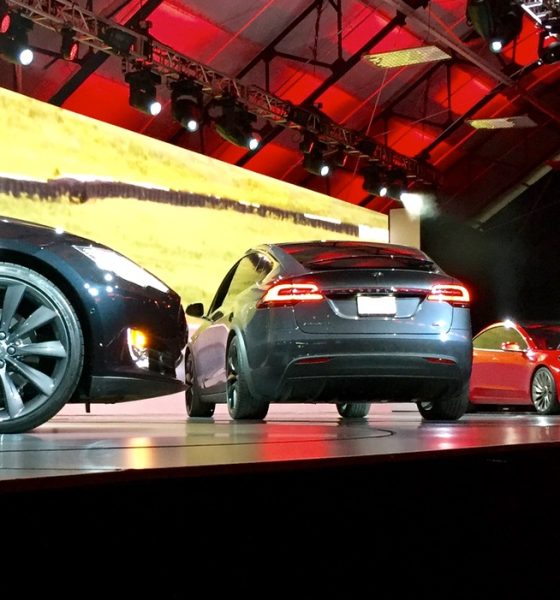
News
Tesla won’t slow despite Edmunds claim that loss of tax credit will “kill the U.S. EV market”
Edmunds has released a new study that claims the loss of federal tax credits for EV buyers is “likely to kill the U.S. EV market.” It goes on to say, “Without these credits, this market is likely to crash.” Edmunds bases its analysis on what happened when the state of Georgia repealed its EV incentive program in the middle of 2015. Not only did Georgia eliminate its EV incentive, it also imposed new fees on EV drivers designed to offset the loss of revenue the state experienced because cars with electric motors use less gasoline.
Up until then, Georgia gave every qualifying EV buyer a $5,000 credit — the largest in the nation. That was on top of the $7,500 federal tax credit and made buying an EV in Georgia a very attractive proposition. The biggest beneficiary was the Nissan LEAF. In June, 2015 — the last month the incentive was available — 1,008 of them were sold or leased. In July, after the rebate was no longer available, 66 cars were delivered.
Cars eligible for the state incentive accounted for up to 17% of the new car market in Georgia. Following the legislature’s decision to eliminate the credit, they have fallen to about 2% of sales. Note that is still higher than the percentage of EV sales in the US as a whole.
Should Tesla be concerned? Not really says the Motley Fool. Data compiled by IHS Markit and included in the Edmunds analysis shows a drop in sales of the Model S shortly after Georgia repealed its rebate but sales quickly recovered and have since gone on to set new records for the company in the Peachtree State.
The federal tax credit was originally a pump priming exercise intended to help EV manufacturers get started. The assumption Congress made when it first enacted the credit was that once a company had sold 200,000 cars with plugs, economies of scale would begin to kick in, making it possible to build and sell electrified cars profitably without government assistance.
Tesla is getting close to that figure and will surely pass it once the Model 3 gets into production this summer. After that, the federal tax credit for Tesla vehicles will begin to phase out. In addition, many people worry the Trump administration will kill the federal EV tax credit entirely. According to Edmunds, that means Tesla could suffer a dramatic decline in sales — at least in the US. Here’s why that won’t happen according to the Motley Fool.
Not so fast
First, any comparison between a 2015 Nissan LEAF and a 2018 Tesla Model 3 is a lopsided contest. The LEAF is a fine car but it suffers from a serious lack of range. Nor does it have any of the industry leading technology Tesla offers its customers. It relies on the CHAdeMO charging standard, which is rapidly losing ground to the CCS standard and the Tesla Supercharger network.
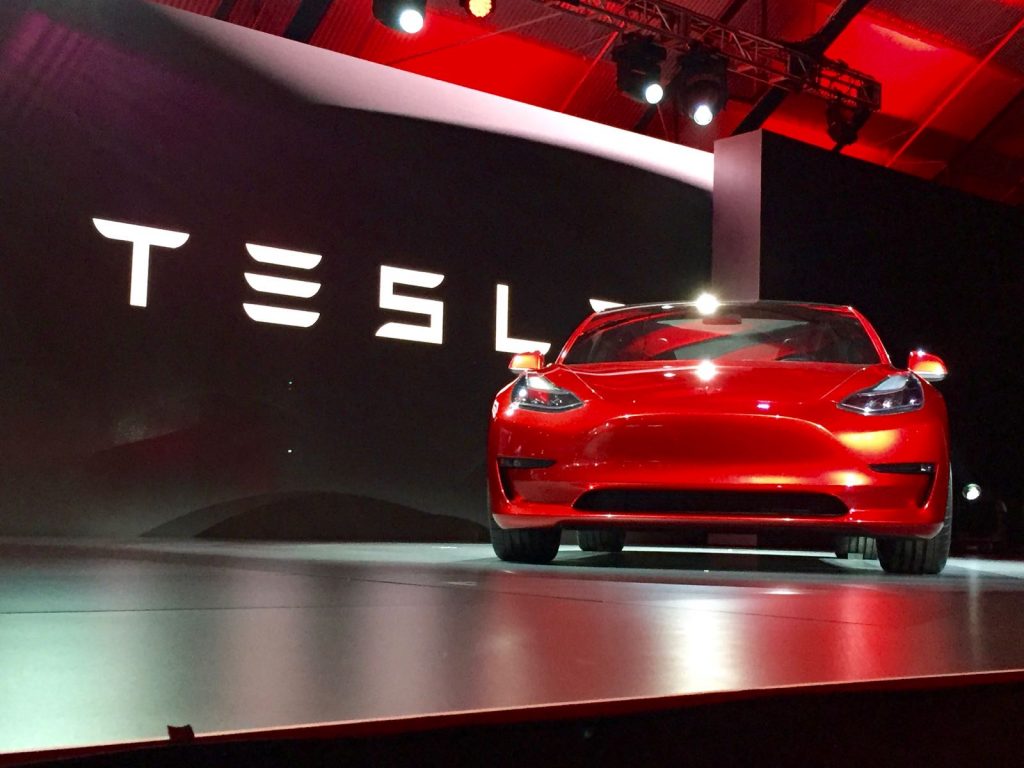
Red Tesla Model 3 at the vehicle unveiling event on March 31, 2016 from the company’s Hawthorne, CA Design Center.
Second, the base price of the Model 3 is $35,000, which happens to be very near the average selling price of a new passenger vehicle in the US market today. With or without incentives, the Model 3 will be highly competitive. With nearly 400,000 reservations worldwide, demand for the Model 3 is clearly not dependent on government financial incentives.
The real issue here is that electric car sales have not advanced as quickly as electric car advocates predicted. Range anxiety, lack of charging infrastructure, and fear of the unknown have kept many people from buying an electric car, whether from Tesla or any other manufacturer. The “tipping point” when electric cars become the first choice of mainstream car buyers is tantalizingly close but still not here yet.
Reasonable people may disagree about the best way to promote electric cars. Paying people to buy them may not be as beneficial to society as subsidizing the infrastructure needed to charge them. The interstate highway system was a hugely expensive undertaking but it unleashed an unprecedented surge in US economic output. Today it is still the backbone of commerce in America. Putting the money used to fund the federal EV tax credit to work building the nation’s charging infrastructure could be a more efficient use of resources.
By any analysis, the Tesla phenomenon is not dependent on government incentives. It is based on building compelling electric automobiles that outperform the competition. Elon Musk deliberately chose to start at the top of the market to attract those who influence public opinion. That strategy is working and will continue to work even if the federal tax credit is eliminated entirely.

Elon Musk
Elon Musk proposes Grok 5 vs world’s best League of Legends team match
Musk’s proposal has received positive reception from professional players and Riot Games alike.

Elon Musk has proposed a high-profile gaming challenge for xAI’s upcoming Grok 5. As per Musk, it would be interesting to see if the large language model could beat the world’ best human League of Legends team with specific constraints.
Musk’s proposal has received positive reception from professional players and Riot Games alike, suggesting that the exciting exhibition match might indeed happen.
Musk outlines restrictions for Grok
In his post on X, Musk detailed constraints to keep the match competitive, including limiting Grok to human-level reaction times, human-speed clicking, and viewing the game only through a camera feed with standard 20/20 vision. The idea quickly circulated across the esports community, drawing commentary from former pros and AI researchers, as noted in a Dexerto report.
Former League pro Eugene “Pobelter” Park expressed enthusiasm, offering to help Musk’s team and noting the unique comparison to past AI-versus-human breakthroughs, such as OpenAI’s Dota 2 bots. AI researcher Oriol Vinyals, who previously reached Grandmaster rank in StarCraft, suggested testing Grok in RTS gameplay as well.
Musk welcomed the idea, even responding positively to Vinyals’ comment that it would be nice to see Optimus operate the mouse and keyboard.
Pros debate Grok’s chances, T1 and Riot show interest
Reactions weren’t universally optimistic. Former professional mid-laner Joedat “Voyboy” Esfahani argued that even with Grok’s rapid learning capabilities, League of Legends requires deep synergy, game-state interpretation, and team coordination that may be difficult for AI to master at top competitive levels. Yiliang “Doublelift” Peng was similarly skeptical, publicly stating he doubted Grok could beat T1, or even himself, and jokingly promised to shave his head if Grok managed to win.
T1, however, embraced the proposal, responding with a GIF of Faker and the message “We are ready,” signaling their willingness to participate. Riot Games itself also reacted, with co-founder Marc Merrill replying to Musk with “let’s discuss.” Needless to say, it appears that Riot Games in onboard with the idea.
Though no match has been confirmed, interest from players, teams, and Riot suggests the concept could materialize into a landmark AI-versus-human matchup, potentially becoming one of the most viewed League of Legends events in history. The fact that Grok 5 will be constrained to human limits would definitely add an interesting dimension to the matchup, as it could truly demonstrate how human-like the large language model could be like in real-time scenarios.
Tesla has passed a key milestone, and it was one that CEO Elon Musk initially mentioned more than nine years ago when he published Master Plan, Part Deux.
As per Tesla China in a post on its official Weibo account, the company’s Autopilot system has accumulated over 10 billion kilometers of real-world driving experience.
Tesla China’s subtle, but huge announcement
In its Weibo post, Tesla China announced that the company’s Autopilot system has accumulated 10 billion kilometers of driving experience. “In this respect, Tesla vehicles equipped with Autopilot technology can be considered to have the world’s most experienced and seasoned driver.”
Tesla AI’s handle on Weibo also highlighted a key advantage of the company’s self-driving system. “It will never drive under the influence of alcohol, be distracted, or be fatigued,” the team wrote. “We believe that advancements in Autopilot technology will save more lives.”
Tesla China did not clarify exactly what it meant by “Autopilot” in its Weibo post, though the company’s intense focus on FSD over the past years suggests that the term includes miles that were driven by FSD (Beta) and Full Self-Driving (Supervised). Either way, 10 billion cumulative miles of real-world data is something that few, if any, competitors could compete with.
Advertisement
–>
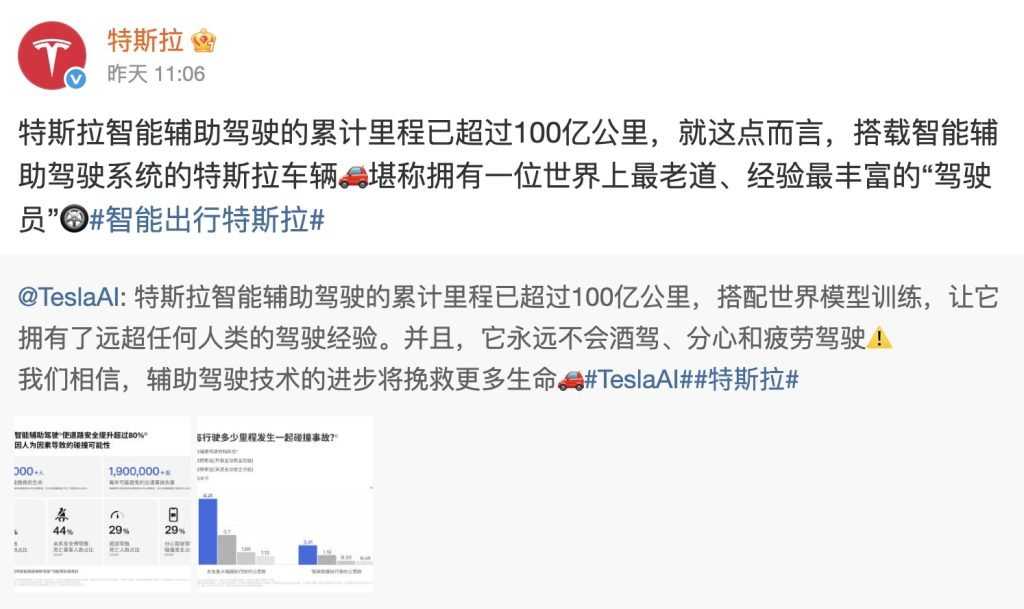
Elon Musk’s 10-billion-km estimate, way back in 2016
When Elon Musk published Master Plan Part Deux, he outlined his vision for the company’s autonomous driving system. At the time, Autopilot was still very new, though Musk was already envisioning how the system could get regulatory approval worldwide. He estimated that worldwide regulatory approval will probably require around 10 billion miles of real-world driving data, which was an impossible-sounding amount at the time.
“Even once the software is highly refined and far better than the average human driver, there will still be a significant time gap, varying widely by jurisdiction, before true self-driving is approved by regulators. We expect that worldwide regulatory approval will require something on the order of 6 billion miles (10 billion km). Current fleet learning is happening at just over 3 million miles (5 million km) per day,” Musk wrote.
It’s quite interesting but Tesla is indeed getting regulatory approval for FSD (Supervised) at a steady pace today, at a time when 10 billion miles of data has been achieved. The system has been active in the United States and has since been rolled out to other countries such as Australia, New Zealand, China, and, more recently, South Korea. Expectations are high that Tesla could secure FSD approval in Europe sometime next year as well.
News
Elon Musk’s Boring Company reveals Prufrock TBM’s most disruptive feature
As it turns out, the tunneling startup, similar to other Elon Musk-backed ventures, is also dead serious about pursuing reusability.
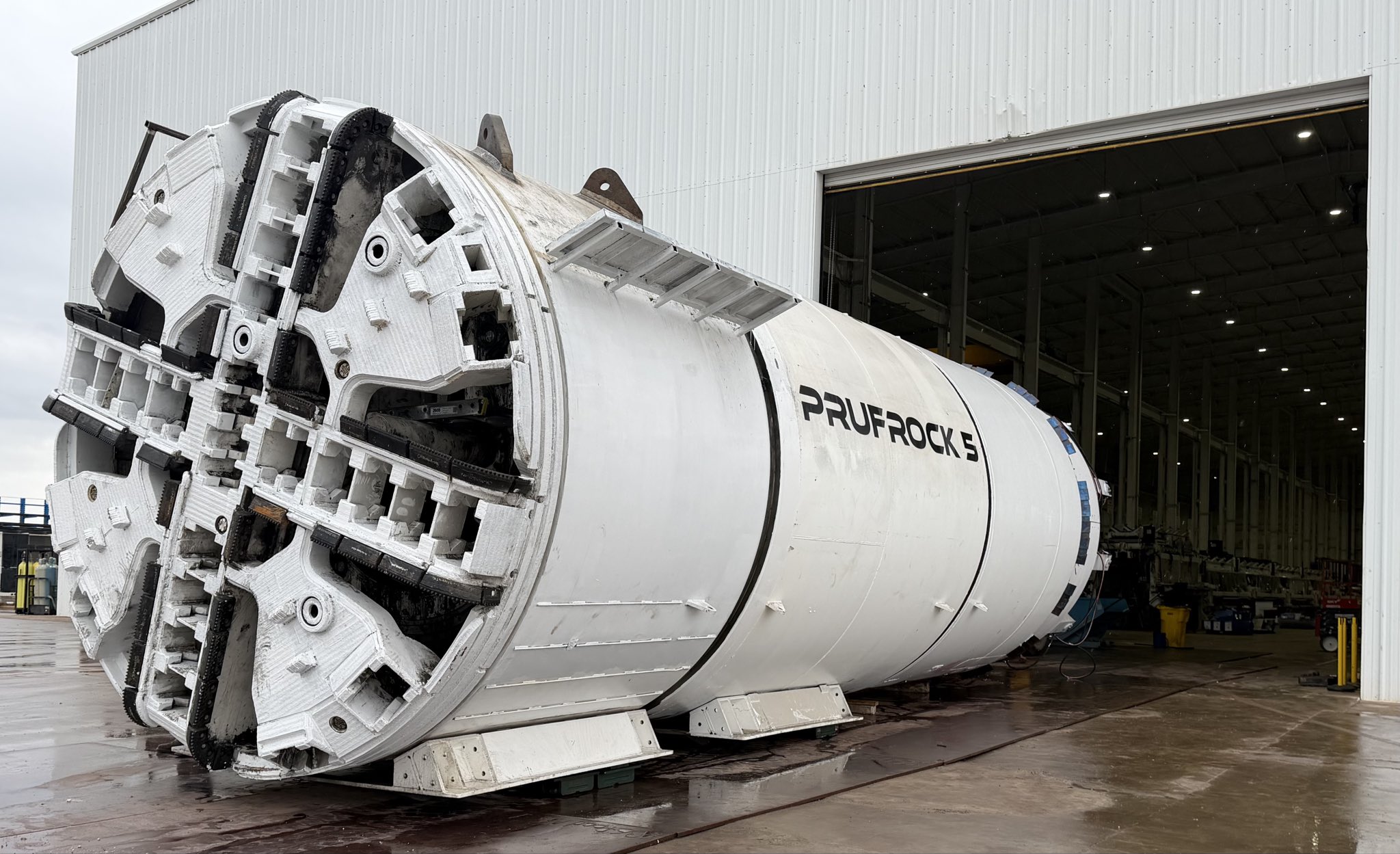
The Boring Company has quietly revealed one of its tunnel boring machines’ (TBMs) most underrated feature. As it turns out, the tunneling startup, similar to other Elon Musk-backed ventures, is also dead serious about pursuing reusability.
Prufrock 5 leaves the factory
The Boring Company is arguably the quietest venture currently backed by Elon Musk, inspiring far fewer headlines than his other, more high-profile companies such as Tesla, SpaceX, and xAI. Still, the Boring Company’s mission is ambitious, as it is a company designed to solve the problem of congestion in cities.
To accomplish this, the Boring Company would need to develop tunnel boring machines that could dig incredibly quickly. To this end, the startup has designed Prufrock, an all-electric TBM that’s designed to eventually be fast enough as an everyday garden snail. Among TBMs, such a speed would be revolutionary.
The startup has taken a step towards this recently, when The Boring Company posted a photo of Prufrock-5 coming out of its Bastrop, Texas facility. “On a rainy day in Bastrop, Prufrock-5 has left the factory. Will begin tunneling by December 1. Hoping for a step function increase in speed,” the Boring Company wrote.
Prufrock’s quiet disruption
Interestingly enough, the Boring Company also mentioned a key feature of its Prufrock machines that makes them significantly more sustainable and reusable than conventional TBMs. As per a user on X, standard tunnel boring machines are often left underground at the conclusion of a project because retrieving them is usually more expensive and impractical than abandoning them in the location.
As per the Boring Company, however, this is not the case for its Prufrock machines, as they are retrieved, upgraded, and deployed again with improvements. “All Prufrocks are reused, usually with upgrades between launches. Prufrock-1 has now dug six tunnels,” the Boring Company wrote in its reply on X.
The Boring Company’s reply is quite exciting as it suggests that the TBMs from the tunneling startup could eventually be as reusable as SpaceX’s boosters. This is on brand for an Elon Musk-backed venture, of course, though the Boring Company’s disruption is a bit more underground.
News
Tesla accused of infringing robotics patents in new lawsuit
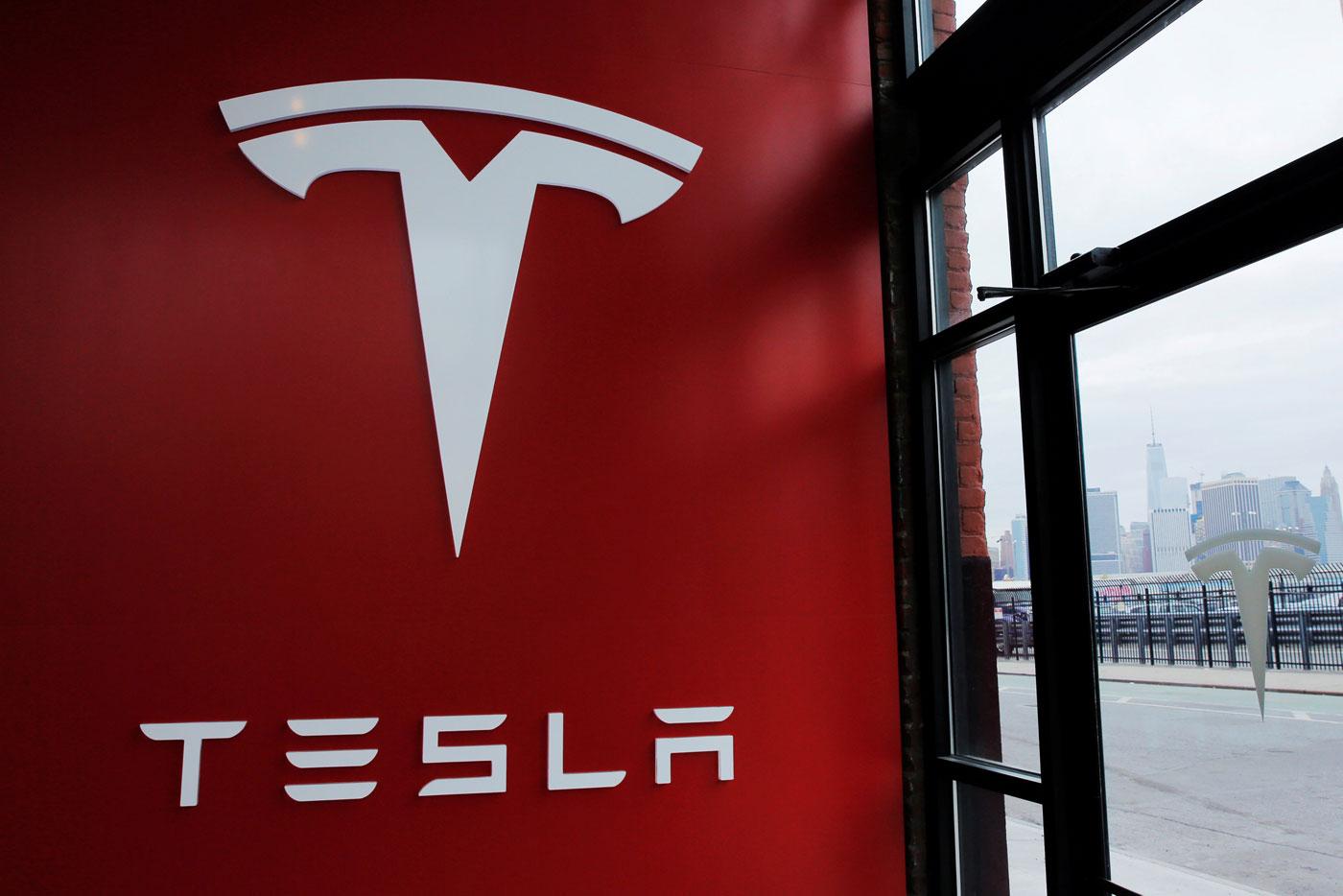
Tesla is being accused of infringing robotics patents by a company called Perrone Robotics, which is based out of Charlottesville, Virginia.
The suit was filed in Alexandria, Virginia, and accuses Tesla of knowingly infringing upon five patents related to robotics systems for self-driving vehicles.
The company said its founder, Paul Perrone, developed general-purpose robotics operating systems for individual robots and automated devices.
Perrone Robotics claims that all Tesla vehicles utilizing the company’s Autopilot suite within the last six years infringe the five patents, according to a report from Reuters.
Tesla’s new Safety Report shows Autopilot is nine times safer than humans
One patent was something the company attempted to sell to Tesla back in 2017. The five patents cover a “General Purpose Operating System for Robotics,” otherwise known as GPROS.
The GPROS suite includes extensions for autonomous vehicle controls, path planning, and sensor fusion. One key patent, U.S. 10,331,136, was explicitly offered to Tesla by Perrone back in 2017, but the company rejected it.
The suit aims to halt any further infringements and seeks unspecified damages.
This is far from the first suit Tesla has been involved in, including one from his year with Perceptive Automata LLC, which accused Tesla of infringing on AI models to interpret pedestrian/cyclist intent via cameras without licensing. Tesla appeared in court in August, but its motion to dismiss was partially denied earlier this month.
Tesla also settled a suit with Arsus LLC, which accused Autopilot’s electronic stability features of infringing on rollover prevention tech. Tesla won via an inter partes review in September.
Most of these cases involve non-practicing entities or startups asserting broad autonomous vehicle patents against Tesla’s rapid iteration.
Tesla typically counters with those inter partes reviews, claiming invalidity. Tesla has successfully defended about 70 percent of the autonomous vehicle lawsuits it has been involved in since 2020, but settlements are common to avoid discovery costs.
The case is Perrone Robotics Inc v Tesla Inc, U.S. District Court, Eastern District of Virginia, No. 25-02156. Tesla has not yet listed an attorney for the case, according to the report.








